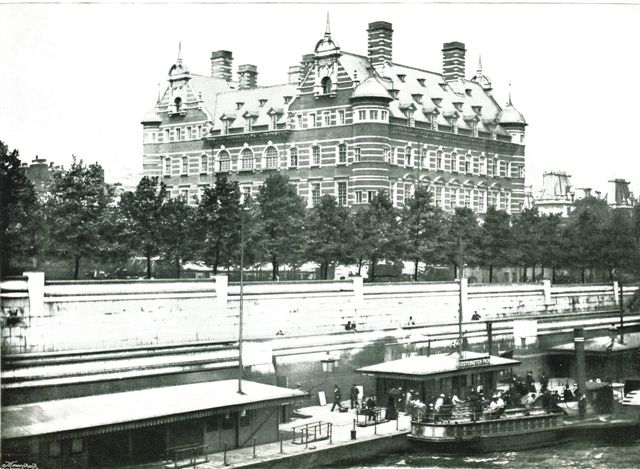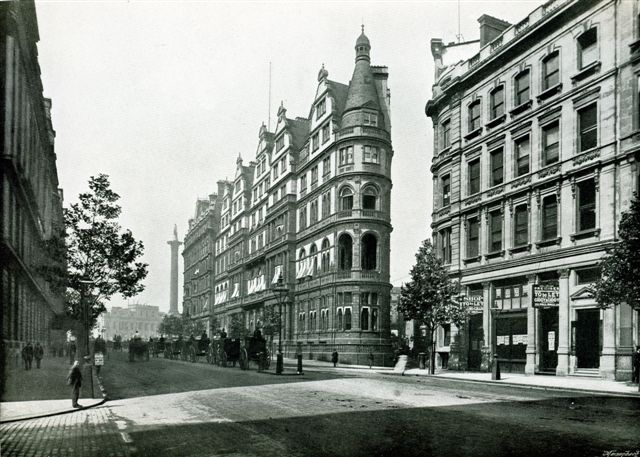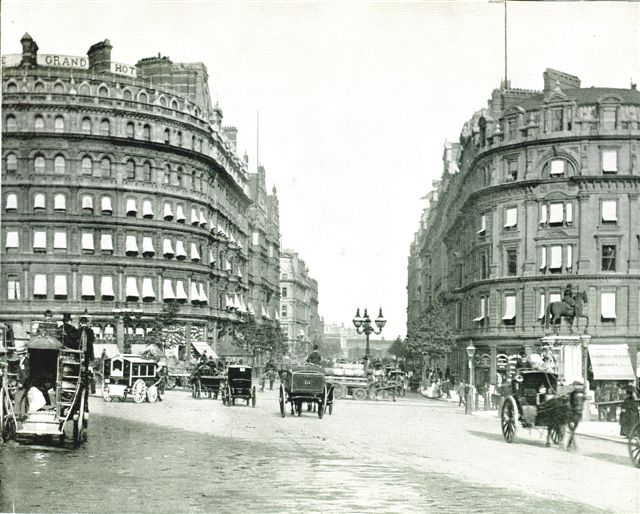|
|
|
 |
VICTORIAN AND EDWARDIAN 'AD' (2) Presented by Ex PC 799 'A'/164477 Leonard Bentley |
 |
|
More images from bygone eras. Pictures and information presented by Ex PC 799 'A' Leonard Bentley who was stationed at AD from 1973 to 1982 As in Len's first page 'Victorian and Edwardian 'AD' (1) all his images are from his personal collection focusing on how the area that Cannon Row Police Station was responsible for policing looked all those years ago. Along with Len's entertaining and informative descriptions accompanying the images we are able to take an enjoyable escorted tour around our our old ground and be taken back more than 100 years. JH. |
|
 |
New Scotland Yard What is missing from this photograph? The building known as Scotland House which included Cannon Row is the missing bit. New Scotland Yard was opened in 1890 and it was soon realised that extra office space was required; this has been a continuing theme because in 1938 the Curtis Greene building was added on the north side of the original. Scotland House was completed in the early part of the 20th century and was connected to the yard by an enclosed bridge above what was then known as Derby Street. The Yard was built on the foundations for a National Opera House, the first stone had been laid in 1875 but the builders soon ran out of money for the project and it languished for some years before being used for the new site of Scotland Yard. It is said that the granite used in the facings of the building were quarried by convicts from Dartmoor Prison. The architect of the new Portcullis House which has replaced the St. Stephen’s club is reported to have designed the large chimneys on the building as a visual reference to those on New Scotland Yard, this monstrosity of a building has a planned life of 200 years. I hope future Londoners are grateful. The paddle steamer seen embarking passengers from Westminster pier is one of a large number of ’penny steamers’ which had been used on the Thames for decades as water buses. Can someone tell me why water buses are never successful today? There always seems to be yet another company attempting to lure commuters onto the river away from the roads, but they are never successful. Although not a paddle steamer, the MV Henley is used today by one of the riverboat companies for trips upriver from Westminster pier and dates from 1896, the approximate date of the photograph.The old wooden buildings used as the ticket office and staff quarters were removed several years ago and I believe are now being used on a wilidlife reserve somewhere in the Chilterns. The London Plane trees which line the embankment seem to be very close together and have undoubtedly been thinned out over the years. I both love and hate London Planes, they are very stately and beautiful but during the pollen season they produce a noxious rain of pollen which as a hay fever sufferer, used to cause me great discomfort; so when in 1981 the London Plane in Cannon Row’s yard toppled over and crushed several cars belonging to members of Parliament you can imagine the mixed emotions. |
 |
National Liberal Club The next two photographs include parts of an adjoining ground, this time Bow Street. The avenue was laid out in 1876 after the destruction of Northumberland House which was situated at the Trafalgar Square end. The aim was to connect Charing Cross and The Victoria Embankment; there was opposition at the time to the removal of Northumberland House which dated from 1605 and an alternative curved avenue was proposed to go around the building but a convenient fire in 1868 put paid to the salvation of the building. The building on the left of the first photograph is The National Liberal Club built between 1884-87, The Liberal Club was probably the most prestigious section house there has ever been when it was used as such in the late seventies; I also seem to remember it being the target for a couple of IRA bombs. The building on the corner of Whitehall place is The Hotel Metropole built in1885 by the Gordon Hotel Company who also built the other avenue hotels, The Hotel Victoria and The Grand Hotel; you can just about see the hotel sign on top of the building. On the right of the photograph is the Avenue theatre, built in 1882 by a property speculator who thought that the site might be needed for an extension to Charing Cross Station. In 1905 whilst work was being carried out on the roof of the station, part of the roof collapsed onto the theatre almost completely destroying it. The theatre was rebuilt and reopened in 1907 and later renamed The Playhouse Theatre. I seem to remember a cab shelter either on or adjacent to the north footway, but the one in the photograph is in the centre of the roadway surrounded by a mixture of Hansom cabs and their four wheel equivalent, the ‘growler’.The last horse drawn Hackney Carriage was withdrawn from use in 1947, does anyone remember it? |
 |
Northumberland Avenue In this photograph the camera is sited at the junction with Great Scotland Yard looking west towards Trafalgar Square, the building on the left is The Hotel Victoria which was opened in 1887 and named for the Queen as it was her Golden jubilee year. The hotel was used as were the others in the avenue as Government offices during the First World War, when the Government bought the Hotel Victoria it became Victoria Buildings and has since been renamed for the original building on the site, Northumberland House. The Hotel Metropole was bought in 1936 and renamed The Metropole Building and has recently been used for the temporary use of MOD staff while the main MOD building in Whitehall is being refurbished |
 |
Trafalgar Square Looking EAST from Cockspur Street This photograph looks east from the end of Cockspur Street, the equestrian statue of King Charles I has stood on this spot since 1676, it was sculpted by Hubert Le Sueur in 1633 from life and was intended for a private garden. After the restoration the statue was placed on the site of the original Eleanor’s Cross which had also been the spot where several Regicides were hanged, drawn and quartered.
The shop just to the right of the statue with the awning is one of the ABC Restaurants which I seem to remember although not at that location. The ABC stood for Aerated Bread Company; the process for aerated bread had been invented in about 1860 by a Dr. Dauglish from Malvern, Worcs. His aim was to obviate the need for yeast and manual kneading which had hygiene issues; he invented a machine which kneaded the bread and injected the dough with carbon dioxide. The bread and cakes made from this process were initially very popular but man cannot live by bread alone and to boost flagging demand the bread shops were turned into restaurants. The restaurant is one of the shops on the ground floor of The Society for promoting Christian Knowledge which turned the corner from Northumberland Avenue into Charing Cross. The area between Great Scotland Yard and the top of Whitehall was called Charing Cross within living memory. There is a Police officer in this photograph; he is standing on the pedestrian island at the end of Northumberland Avenue, obviously looking for process. |
 |
Trafalgar Square looking SOUTH EAST This photograph shows Trafalgar Square from the northwest corner and something is going on in front of the box on the southeast corner. There is a Police officer apparently talking to a man by the fountain while an Inspector looks on. Whenever I was posted to the square my main interest were the persons who frequented the north side behind the raised flowerbeds. Runaways, wanted on warrant, they were all there but if you wanted to do a CRO check on the radio, and these were the days before the PNC, the reply would always be “use the box”. It was good training and a confidence builder if you could talk someone into walking over to the box. I was told that the light which sits on top of the box came from HMS Victory but I am not sure how true that is. The fountains date from 1845 and were revamped just before the Second World War by Sir Edwin Lutyens as memorials to Admirals Beatty and Jellicoe. The statuary including the spouting dolphins were added post war On the left where South Africa House should be is Morley’s Hotel, it was built in 1831 on the site of The Golden Cross Hotel which had been a famous coaching Inn. The building seen at the top of Whitehall just behind the King Charles statue dates from 1865 and was a branch of The National Bank. It is the lone survivor in that row of buildings from that date. |
|
Trafalgar Square Looking North East From Cockspur Street This picture was taken from an elevated position in Cockspur Street and looks northeast; there are two Police officers on the square at what looks like 3.40p.m.according to the clock on St. Martin in the fields. A cabby is taking a break on the west side and has provided his horse with a nosebag. The building on the west side of the square housed the Union Club and The Royal College of Physicians; it dates from 1825 and was designed by Sir Robert Smirke. The building became Canada House in 1925 after it was renovated. The famous equestrian statue of George IV stands on its plinth in the northeast corner, it was originally made to grace the top of Marble Arch but it took so long to make that by the time it was ready Marble Arch had been dismantled from its position outside Buckingham House (later renamed Buckingham Palace). The statue was then placed on the plinth temporarily. The last statue I will mention is the statue of General Gordon dating from 1888 in the middle of the square; it was subsequently removed and now stands in Victoria Embankment Gardens. CLICK ON THIS IMAGE TO CONTINUE YOUR ESCORTED TOUR OF 'VICTORIAN AND EDWARDIAN AD' . Victorian and Edwardian AD (3) |
|
| CLICK ON THE HELMET IMAGE TO RETURN TO 'SIGNPOST' (Express Navigation) OR To re trace your steps select 'Victorian and Edwardian AD (1)' from menu at top of page.
|
|